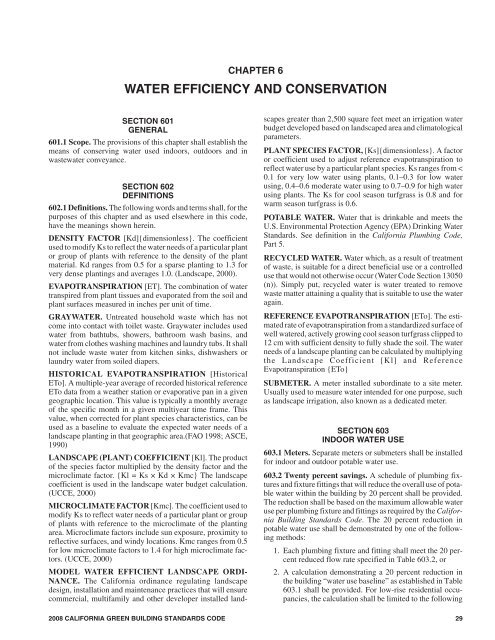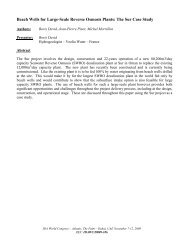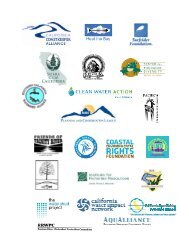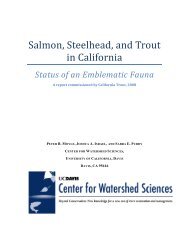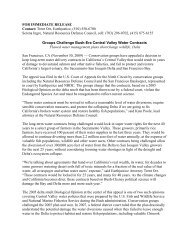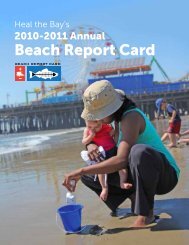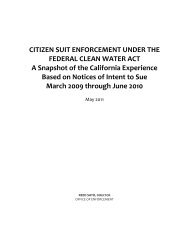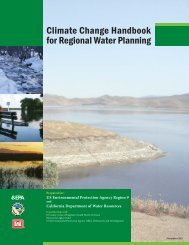Green Building Standards Code - State of California
Green Building Standards Code - State of California
Green Building Standards Code - State of California
Create successful ePaper yourself
Turn your PDF publications into a flip-book with our unique Google optimized e-Paper software.
CHAPTER 6<br />
WATER EFFICIENCY AND CONSERVATION<br />
SECTION 601<br />
GENERAL<br />
601.1 Scope. The provisions <strong>of</strong> this chapter shall establish the<br />
means <strong>of</strong> conserving water used indoors, outdoors and in<br />
wastewater conveyance.<br />
SECTION 602<br />
DEFINITIONS<br />
602.1 Definitions. The following words and terms shall, for the<br />
purposes <strong>of</strong> this chapter and as used elsewhere in this code,<br />
have the meanings shown herein.<br />
DENSITY FACTOR [Kd]{dimensionless}. The coefficient<br />
used to modify Ks to reflect the water needs <strong>of</strong> a particular plant<br />
or group <strong>of</strong> plants with reference to the density <strong>of</strong> the plant<br />
material. Kd ranges from 0.5 for a sparse planting to 1.3 for<br />
very dense plantings and averages 1.0. (Landscape, 2000).<br />
EVAPOTRANSPIRATION [ET]. The combination <strong>of</strong> water<br />
transpired from plant tissues and evaporated from the soil and<br />
plant surfaces measured in inches per unit <strong>of</strong> time.<br />
GRAYWATER. Untreated household waste which has not<br />
come into contact with toilet waste. Graywater includes used<br />
water from bathtubs, showers, bathroom wash basins, and<br />
water from clothes washing machines and laundry tubs. It shall<br />
not include waste water from kitchen sinks, dishwashers or<br />
laundry water from soiled diapers.<br />
HISTORICAL EVAPOTRANSPIRATION [Historical<br />
ETo]. A multiple-year average <strong>of</strong> recorded historical reference<br />
ETo data from a weather station or evaporative pan in a given<br />
geographic location. This value is typically a monthly average<br />
<strong>of</strong> the specific month in a given multiyear time frame. This<br />
value, when corrected for plant species characteristics, can be<br />
used as a baseline to evaluate the expected water needs <strong>of</strong> a<br />
landscape planting in that geographic area.(FAO 1998; ASCE,<br />
1990)<br />
LANDSCAPE (PLANT) COEFFICIENT [Kl]. The product<br />
<strong>of</strong> the species factor multiplied by the density factor and the<br />
microclimate factor. {Kl = Ks × Kd × Kmc} The landscape<br />
coefficient is used in the landscape water budget calculation.<br />
(UCCE, 2000)<br />
MICROCLIMATE FACTOR [Kmc]. The coefficient used to<br />
modify Ks to reflect water needs <strong>of</strong> a particular plant or group<br />
<strong>of</strong> plants with reference to the microclimate <strong>of</strong> the planting<br />
area. Microclimate factors include sun exposure, proximity to<br />
reflective surfaces, and windy locations. Kmc ranges from 0.5<br />
for low microclimate factors to 1.4 for high microclimate factors.<br />
(UCCE, 2000)<br />
MODEL WATER EFFICIENT LANDSCAPE ORDI-<br />
NANCE. The <strong>California</strong> ordinance regulating landscape<br />
design, installation and maintenance practices that will ensure<br />
commercial, multifamily and other developer installed landscapes<br />
greater than 2,500 square feet meet an irrigation water<br />
budget developed based on landscaped area and climatological<br />
parameters.<br />
PLANT SPECIES FACTOR, [Ks]{dimensionless}. A factor<br />
or coefficient used to adjust reference evapotranspiration to<br />
reflect water use by a particular plant species. Ks ranges from <<br />
0.1 for very low water using plants, 0.1–0.3 for low water<br />
using, 0.4–0.6 moderate water using to 0.7–0.9 for high water<br />
using plants. The Ks for cool season turfgrass is 0.8 and for<br />
warm season turfgrass is 0.6.<br />
POTABLE WATER. Water that is drinkable and meets the<br />
U.S. Environmental Protection Agency (EPA) Drinking Water<br />
<strong>Standards</strong>. See definition in the <strong>California</strong> Plumbing <strong>Code</strong>,<br />
Part 5.<br />
RECYCLED WATER. Water which, as a result <strong>of</strong> treatment<br />
<strong>of</strong> waste, is suitable for a direct beneficial use or a controlled<br />
use that would not otherwise occur (Water <strong>Code</strong> Section 13050<br />
(n)). Simply put, recycled water is water treated to remove<br />
waste matter attaining a quality that is suitable to use the water<br />
again.<br />
REFERENCE EVAPOTRANSPIRATION [ETo]. The estimated<br />
rate <strong>of</strong> evapotranspiration from a standardized surface <strong>of</strong><br />
well watered, actively growing cool season turfgrass clipped to<br />
12 cm with sufficient density to fully shade the soil. The water<br />
needs <strong>of</strong> a landscape planting can be calculated by multiplying<br />
the Landscape Coefficient [Kl] and Reference<br />
Evapotranspiration {ETo}<br />
SUBMETER. A meter installed subordinate to a site meter.<br />
Usually used to measure water intended for one purpose, such<br />
as landscape irrigation, also known as a dedicated meter.<br />
SECTION 603<br />
INDOOR WATER USE<br />
603.1 Meters. Separate meters or submeters shall be installed<br />
for indoor and outdoor potable water use.<br />
603.2 Twenty percent savings. A schedule <strong>of</strong> plumbing fixtures<br />
and fixture fittings that will reduce the overall use <strong>of</strong> potable<br />
water within the building by 20 percent shall be provided.<br />
The reduction shall be based on the maximum allowable water<br />
use per plumbing fixture and fittings as required by the <strong>California</strong><br />
<strong>Building</strong> <strong>Standards</strong> <strong>Code</strong>. The 20 percent reduction in<br />
potable water use shall be demonstrated by one <strong>of</strong> the following<br />
methods:<br />
1. Each plumbing fixture and fitting shall meet the 20 percent<br />
reduced flow rate specified in Table 603.2, or<br />
2. A calculation demonstrating a 20 percent reduction in<br />
the building “water use baseline” as established in Table<br />
603.1 shall be provided. For low-rise residential occupancies,<br />
the calculation shall be limited to the following<br />
2008 CALIFORNIA GREEN BUILDING STANDARDS CODE 29


